Spring has officially arrived, and we are frantically dashing about preparing for the impending season. In order to have a steady stream of material for mixed bouquets, bulk orders and beautiful wedding bouquets, I have taken extra care to stock the garden with a huge supply of foliage and filler plants. While often overlooked, these simple but beautiful plants are the backbone of a good flower patch. Filled with fragrance, texture, unexpected and unusual elements, the following list carries our farm through a season of floral bounty.
While most of the varieties I’m going to list here are easy-to-grow annuals, it’s always nice to tuck in a patch of woody cuts somewhere on your property for large-scale arranging. Nothing is more satisfying than tromping out back and sawing off a 5-foot hunk of foliage to make up a massive arrangement. My favorites: copper beech (Fagus sylvatica), hornbeam (Carpinus betula), ‘Evereste’ crabapple (Malus), ninebark (Physocarpus), and bush honeysuckle (Lonicera tartarica).
Pictured above: ‘Nugget’ ninebark and a spring bouquet featuring bush honeysuckle, ninebark seed casings and rambling rose foliage.
Here are some excellent sources for trees and shrubs: Bailey Nurseries, which is family-owned and has six regional nurseries in different parts of the U.S.; Biringer Nursery, here in Mount Vernon, Washington; Blue Bird Nursery, based in Nebraska; and Spring Meadow Nursery and Walters Gardens, both based in Michigan.
Keep in mind that if you are ordering bareroot plants, you should place your order in winter or early spring and have a spot ready for your trees and shrubs when they arrive.
Queen Anne’s Lace ‘Green Mist’, ‘Casablanca’ (Ammi visagna), and ‘Graceland’ (Ammi majus): We grow all three in large quantities and always use every single stem. While the smell is a bit off-putting (similar to turpentine), Ammi is truly a wonderful filler. The lacy flower heads, great vase life, and clean green-white color provide an invaluable backbone for our late spring-early summer bouquets.
Ammi (Daucus) ‘Black Knight’: This burgundy-chocolate colored Queen Anne’s Lace has been an absolute hit for us! It looks great in bouquets, sells well with designers and blooms almost all summer from just one planting. The vase life is phenomenal (10-plus days), the blooms don’t shatter like traditional Ammi, and the coveted chocolate color that is hard to find. We space plants 18×18 inches (45×45 cm) and add a low layer of netting to keep the flower-laden plants from toppling in summer rains.
Note: Be sure when harvesting all Queen Anne’s Lace varieties that you wear long sleeves and gloves because the sap can burn sensitive skin when exposed to bright sunlight.
Pictured above: A bucket of my favorite early summer fillers: Queen Anne’s lace, cress and wheat.
Left to right: Scented geraniums, bells of Ireland, and cress.
Scented Geraniums: Designers will stampede you for fresh bunches of these treasures, so be warned! I adore ‘Attar of Rose’, ‘Lemon Fizz’, ‘Chocolate’, ‘Ginger’ and ‘Bitter Lemon’. It’s essential to delay harvest until the plants have matured enough for the stems to harden up a bit, or they will wilt and not recover. If picked at the proper time (early morning or in the cool of the evening), slipped right into water and then tucked into the cooler for a few hours, they’ll have a very good vase life.
Bells of Ireland: One of the finest and easiest annual foliages you can grow. Every year we double our crop, and every year we run out. This season I have scheduled six plantings and hope it carries us through the summer. I’ve found that designers are eager for farm fresh bells of Ireland since the ones sold through commercial wholesalers lack leaves, are often smashed flat, and tend to be moldy. Ours are planted in heavily amended ground, 18×18 inches (45×45 cm) apart with three rows to a bed. Netting is essential, since one big rain storm will flatten the entire patch. If there is enough greenhouse space available I prefer to plant them inside as well.
Cress (Lepidium sativum): I discovered this fantastic filler a few seasons back and have been a fan ever since. Just a few stems of these seedy treasures, and every bouquet is transformed. We direct sow it in the spring, staggering five plantings 2 weeks apart for an extended harvest. Fresh, it persists well over 10 days, and any excess can be dried for fall bouquets and holiday work.
Pictured above (left to right): Bells of Ireland, Queen Anne’s lace, and flax.
Flax (Linum usitatissimum): We’ve been growing this crop for a few seasons now, and I’m still head over heels in love with it. Its delicate, seedy wands almost dance in bouquets, and you can’t go wrong combining it with sunflowers. It can be cut green or left to dry for fall bouquets.
Basil: One of the most fragrant and abundant summer foliages in the garden. In my opinion, ‘Oriental Breeze’ is the most stunning variety of all, sporting deep purple flowers, glossy foliage, and a fantastic scent. Cinnamon, Lemon and ‘Aromatto’ are wonderful workhorses too. Last year we grew ‘Cardinal’ for the first time. The flower heads were pretty but a bit bulky. If pinched early on, it produced nice, usable stems that were great in bouquets. In our cool climate, basil must be grown under cover to lessen disease pressure and extend stem length. Plants are spaced 9×9 inches (23×23 cm) sapart and planted into preburned landscape fabric.
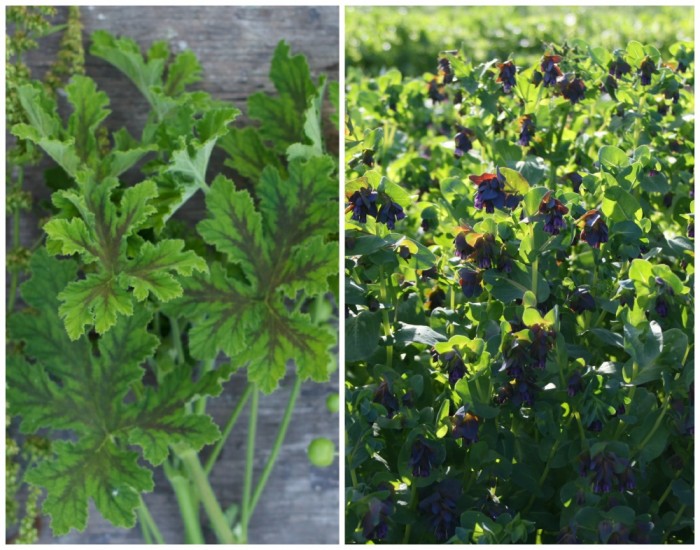
Scented Geranium ‘Chocolate’: Hands down my favorite geranium variety. We grow this beauty in an unheated greenhouse and are able to use the tall stems in late summer mixed bouquets. The chocolate vein and large leaves make this guy a real winner.
Cerinthe major: I just adore this unique plant. In full bloom, one stem can be silver, blue, purple, and green all at the same time. Designers love it, brides love it, it looks great in mixed bouquets and is awesome in arrangements. While Cerinthe (also known as Honeywort) has a great vase life (7 to 10 days) once hardened off, it can be a little tricky at first to get hydrated while keeping the stems straight. I wrap bunches snuggled in a newspaper collar, give the bottom 2 inches a 10- to 15-second dip in boiling water, and stick them in the cooler overnight to harden up. By morning the stems are stiff, straight, and ready to work with. For an extended window of harvest I stagger three plantings about 3 weeks apart in the spring. One plant will produce 7 to 10 stems if harvested often. Cut deep into the plant to encourage long, repeat-blooming stems.
Raspberries: I started using Raspberry greens in bouquets years ago, and they are still on my top favorite list of things we grow. The greens last over 2 weeks in the vase and are wildly productive, providing foliage all season long. Designers and retail customers adore it. The everbearing varieties (‘Summit’ and ‘Golden’) are best for an extended harvest of fruiting stems, can be cut to the ground in the winter for easy clean up, spread rapidly for increased stock, grow in poorer soil than traditional summer-fruiting types, and fruit in yellow and red.
Nigella pods: Designers and wholesalers love the black-podded variety, while I adore the green in mixed bouquets and arrangements. Plants are easily direct seeded and seem to do better when not transplanted. I aim for five sowings about 2 weeks apart to stagger the harvest. If all pods are not used, they can be dried and look lovely in fall bouquets. My ‘Starry Night’ custom blend mix is available in the Floret Shop.
Buckets of unique foliage for an event designer’s order. The mix included ferns, scented geraniums, grasses, Queen Anne’s lace, flax, cress, and raspberry greens.
Amaranth: I have grown just about every variety on the market, and while all are awesome, only a handful get planted en masse every year. The hanging green viridis is a staple with local designers and looks smashing in large arrangements. ‘Opopeo’ (pictured right) is my favorite upright dark variety. It ripens in half the time of others, just 60 days, and is an intense burgundy. ‘Hot Biscuits’ (pictured left) is an incredible brown-gold that is stunning in fall bouquets. ‘Green Tower’ and ‘Green Thumb’ are both super-useful in mixed bouquets. ‘Coral Fountain’ is a heartbreakingly beautiful hanging pink variety that looks like faded, crushed velvet. We grow all of our amaranth with 12×12 inch (30×30 cm) spacing, 4 rows to a bed. They get a pinch at 12 inches (30 cm) to encourage branching and a more usable stem size.
There are so many amazing varieties I haven’t yet captured with the camera or at least can’t track down at this moment. You can search online for them for general idea of what they’ll look like, but just know, they’ve all made the cut!
Atriplex green and bronze: I discovered this fantastic plant in a friend’s veggie patch some years back and have been a huge fan ever since. Early in the season the leafy stems can be harvested en masse for bouquets. The more you cut, the more it produces. Stems hold best when given a quick searing treatment directly after harvest. Just dip the bottom 2 inches (5 cm) of the stems into boiled water for 10 to 15 seconds and then plunge them into a bucket of cool water. If plants are left to grow on, you will be rewarded with gorgeous seedy stems by midsummer that are a favorite with designers and are wonderful in bouquets. Seeded stems do not need any special postharvest treatment and often last 2 weeks. For a large flush of smaller, more usable stems, be sure to pinch plants hard at 12-18 inches (30-45 cm). Succession plant every few weeks for an extended harvest.
Bupleurum: I never have too much bupleurum. Just a few stems in a bouquet, and the whole thing sparkles. I stopped growing it as wholesale bunched item last year since the price is often too low to bother with. I sow about a 1,000 plugs every 2 weeks from early March through mid-May. Plants are spaced 9×9 inches (23×23 cm). We used to net them but found picking to be tricky and have since quit. The trick to germinating bupleurum is to keep it cool and dark. I broadcast seed into 72-cell seed trays, cover with a fine layer of potting soil, wrap the flat in black plastic and tuck it under the seed benches. Germination takes 10 to 14 days, and I consistently get a 90- to 100-percent germination rate.
Cardoon leaves: The thick silver leaves of cardoons are a wonderful addition to the cutting patch. They are one of the first greens in the spring and are actually a cut-and-come-again plant, so the more you harvest the more the plant produces. They last a surprisingly long time in the vase and are ideal for large statement pieces.
Grains: Often in the spring we’ll leave a patch of cover crop in place to use as filler in spring bouquets. My favorites to mix into early bouquets are wheat, oats, rye, and barley.
Dill: We grow ‘Bouquet’ dill. Direct sown every 2 weeks, it provides a nice fragrant addition to our high summer bouquets.
Grasses: We grow loads of grasses, but if I had to pick my favorite I’d chose Panicum ‘Fiber Optic’ and Panicum millaceum ‘Viloaceum’. Both are wildly productive and super simple to grow. Our plants are spaced 9×9 inched (23×23 cm) with five rows to a bed. ‘Violaceum’ resembles miniature, drooping broom corn and looks amazing in bouquets. ‘Fiber Optic’ is a true workhorse, cranking out buckets of stems every few days. For a summer-long harvest we aim for three succession plantings.
Millets (Seteria): I grow ‘Red Jewel’, ‘Limelight’, ‘Purple Mist’, macrostachya and ‘Highlander’ in mass. They are all super-productive and work great in mixed bouquets.
Mint: I was advised to never plant this vigorous spreader but am so glad I didn’t listen. It’s one of the first foliages in the garden and makes early bouquets possible. It has an awesome vase life and a wonderful smell, and planting stock increases rapidly. My favorite varieties are ‘Apple’, Peppermint, ‘Pineapple’ (white variegated), and ‘Spearmint’.
Monarda lambata: New to me last year, this pretty Monarda saved my bacon in mixed bouquets. It is very productive, easy to grow from seed, smells nice, and holds well in arrangements. I spaced it 18×18 inches (45×45 cm), three rows per bed with one layer of netting.
Parsley curled: While not an obvious choice, the crinkled rich leaves are super hardy and invaluable in the fall garden. My patch was still going strong late in the season after everything else had faded or been killed by early frost. Last fall I was able to harvest armloads for Thanksgiving centerpieces. Surprisingly, parsley also has a great vase life of over a week.
Shiso (Perilla frutescens): A stunning dark foliage plant that is coveted by our local designers. Perilla is easy to grow and, if given ample room with 18×18-inch (45×45 cm) spacing, will reward you with 15 to 20 stems per plant. Be sure to let it get nice and ripe before picking or it will wilt; it’s similar to basil in that regard. If you pick it too young, dip stem ends in boiling water for 15 to 20 seconds, and it will perk back up. I’ve had stems last for 2 weeks in the vase! ‘Britton’ is a beautiful variety with rich green leaves that have a deep red underside.
Sweet Pea vines: A surprisingly wonderful filler, these wild-looking vines add whimsy and interest to arrangements. We typically get about a week’s vase life from plant material.
I’d love to know which foliages and fillers are your favorites.
Retail seed sources: Floret Seeds, Johnny’s Selected Seeds
Wholesale seed sources: Gloeckner, Geo and Ivy Garth
Scented Geranium plugs can be sourced through Gloeckner and once you have mother plants, you can propagate your own.

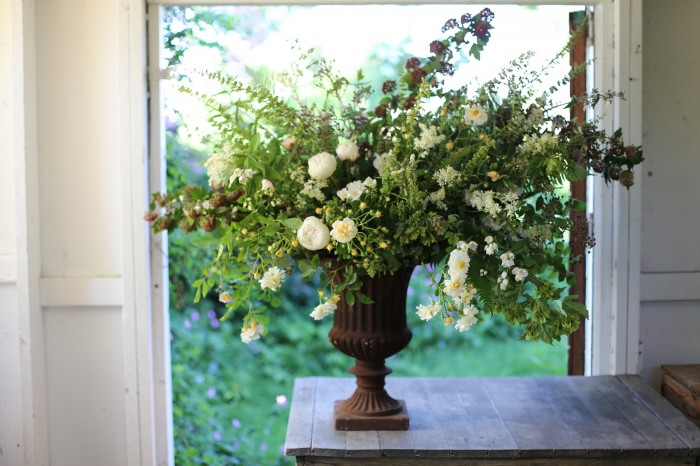
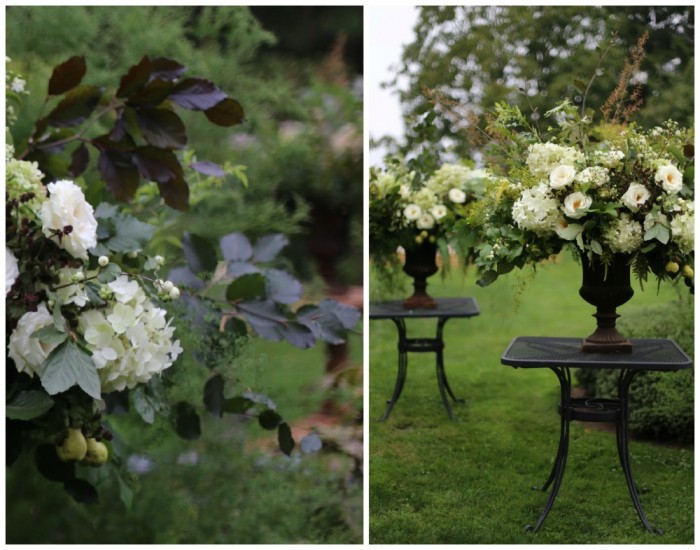
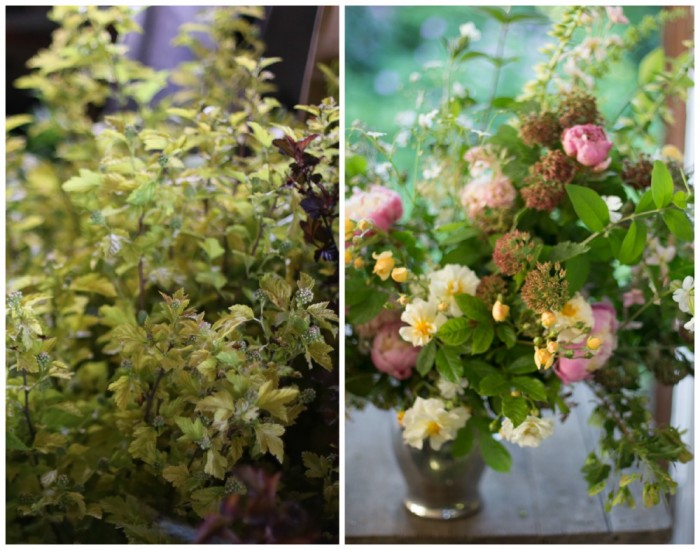
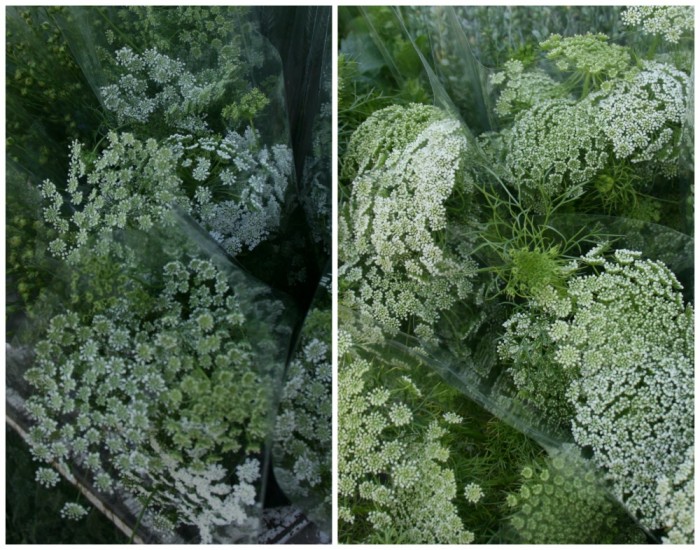
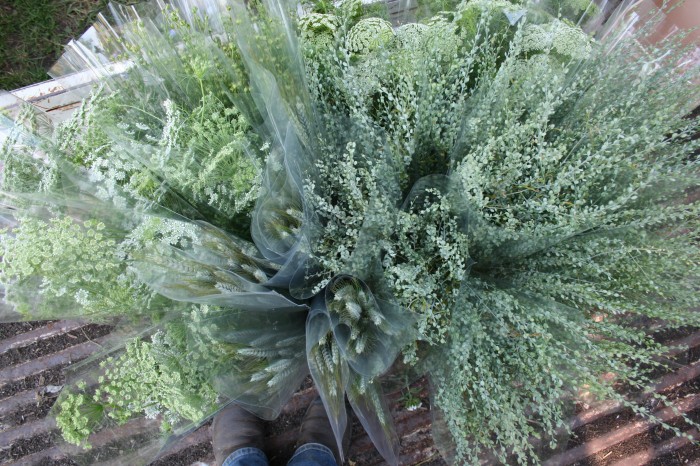
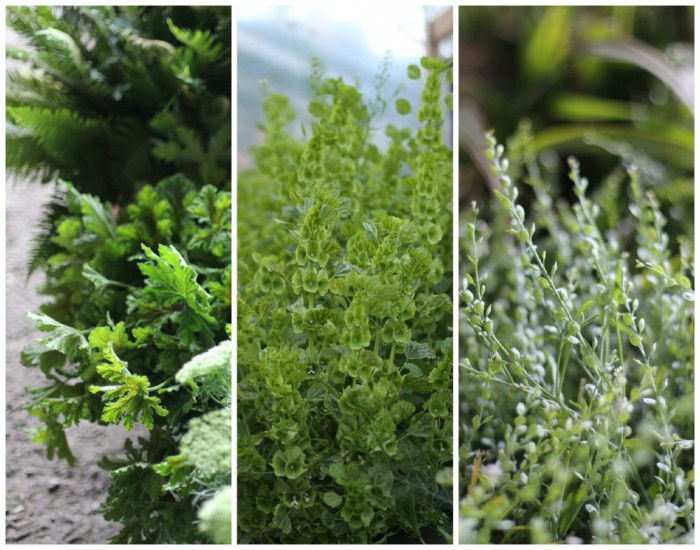
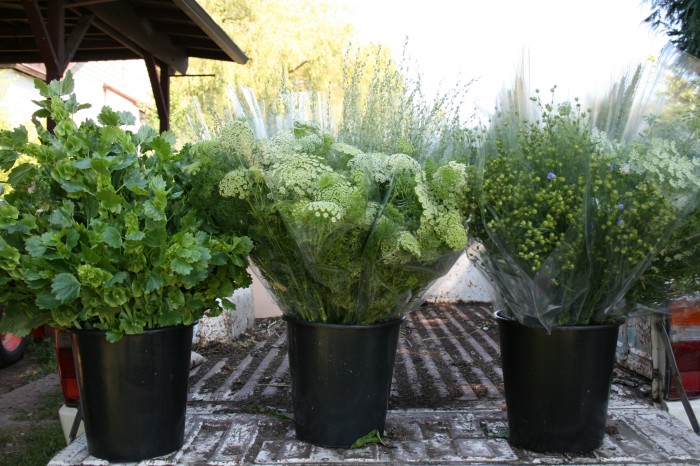
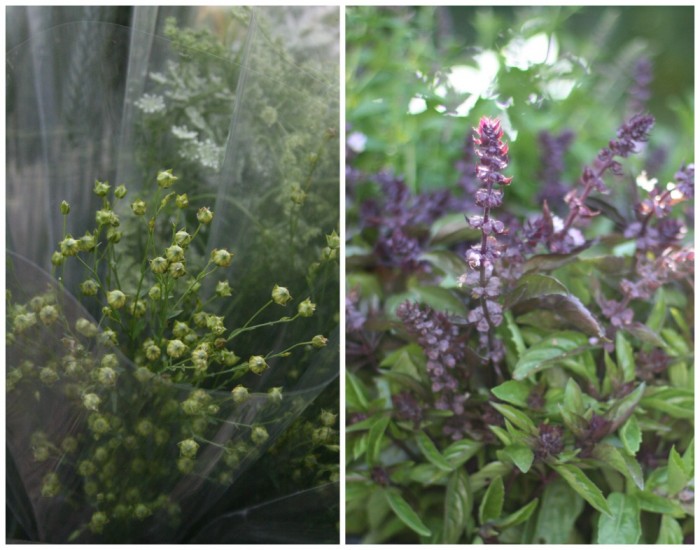
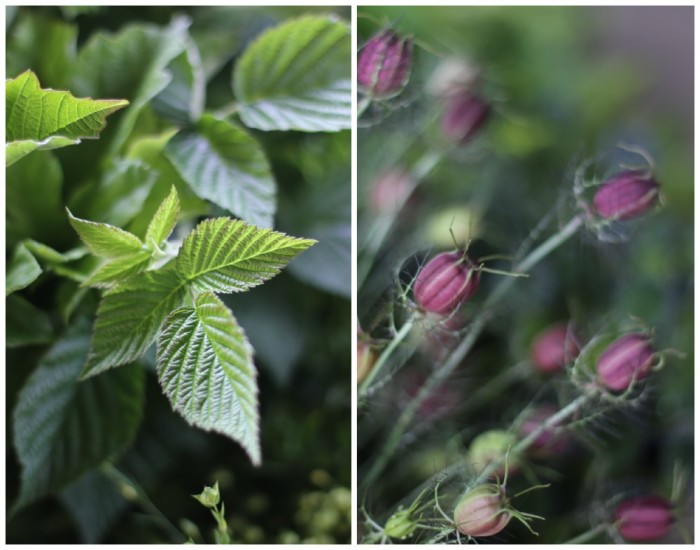
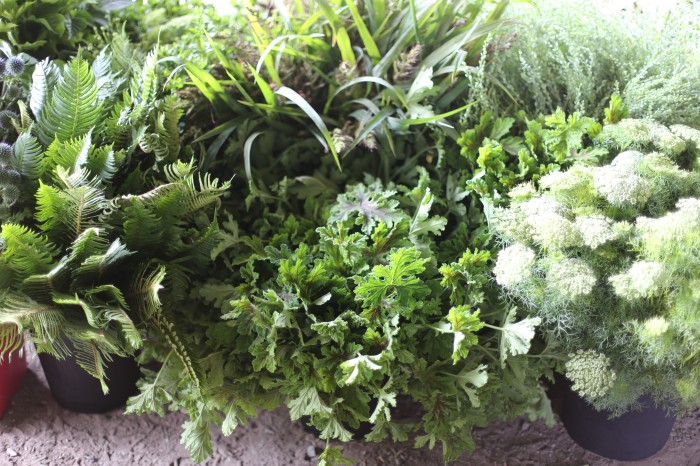
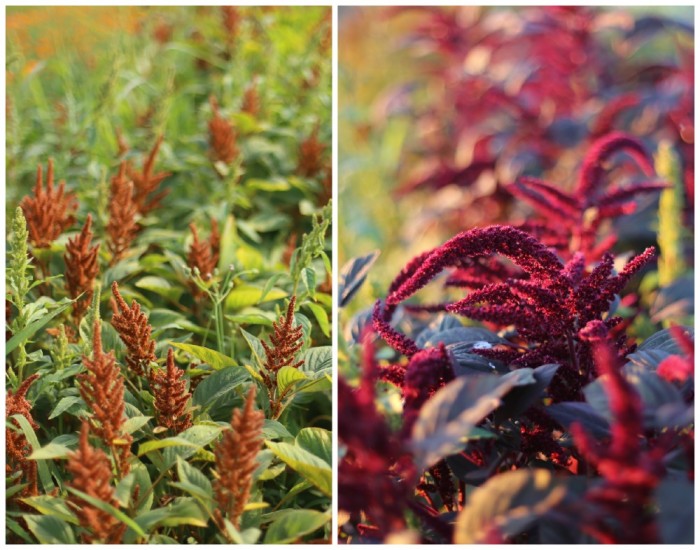
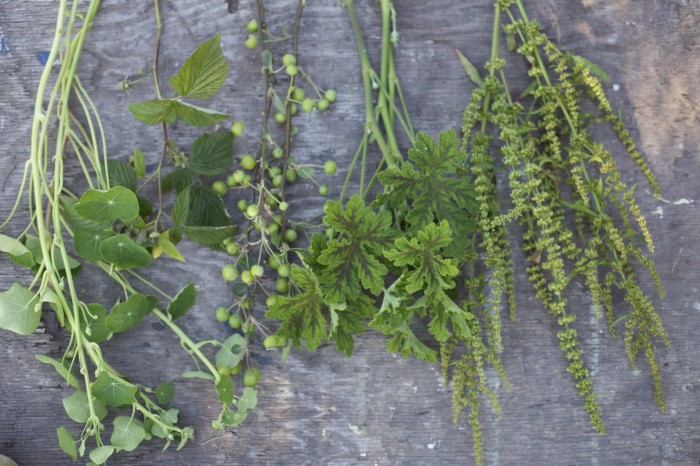
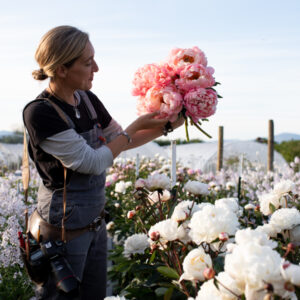
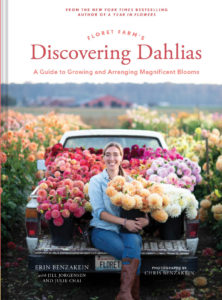
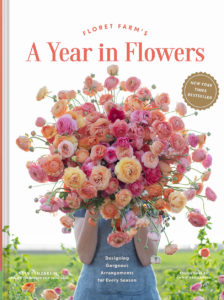
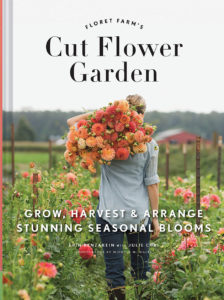

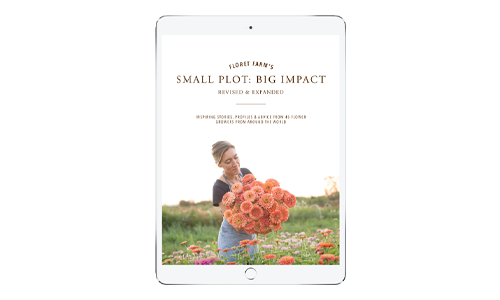
Michal Hubbard on
What would you suggest as a ratio of focal flowers to foliage? Like if you were to plant 400 sq ft, what would your ratio be?